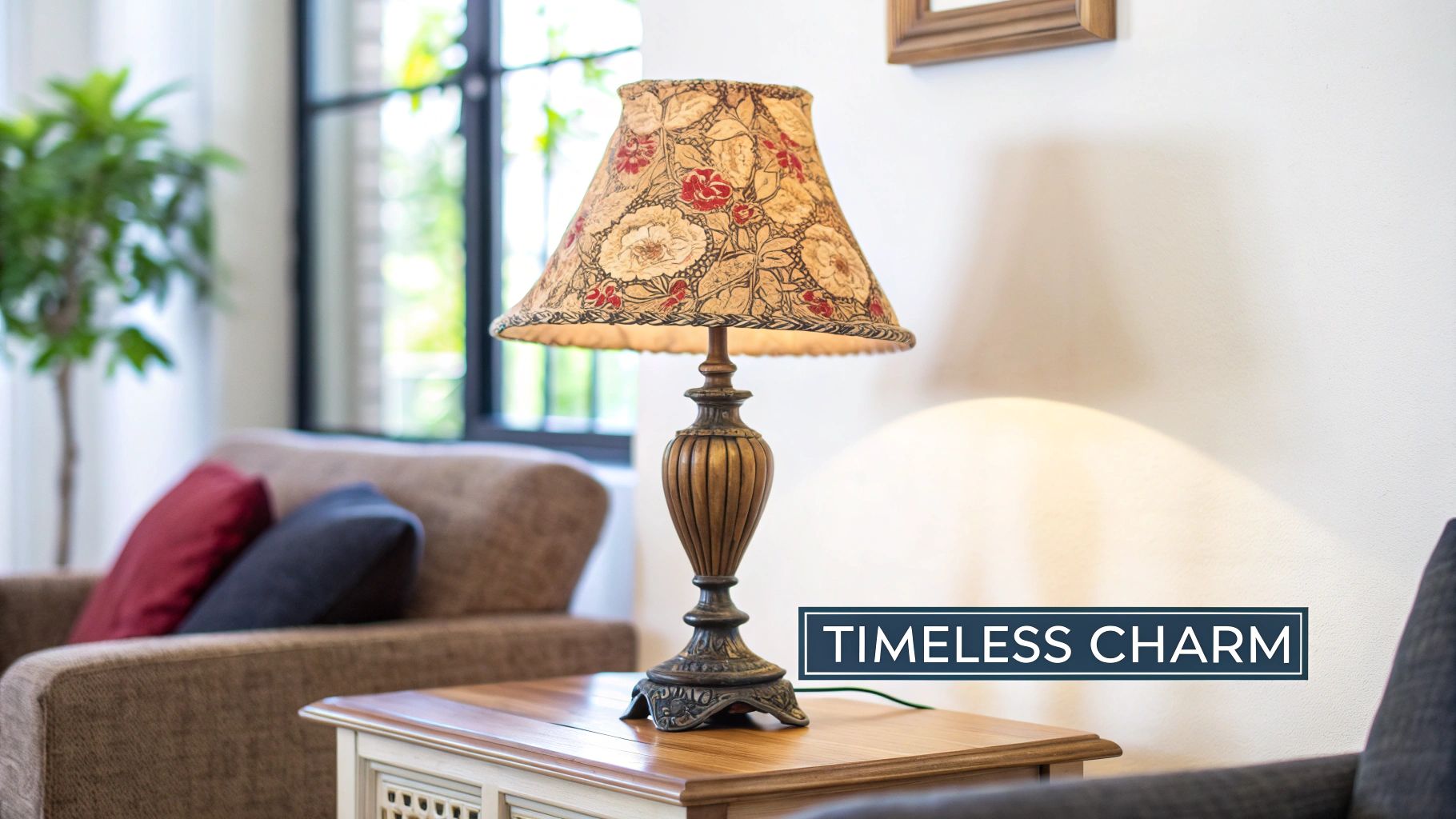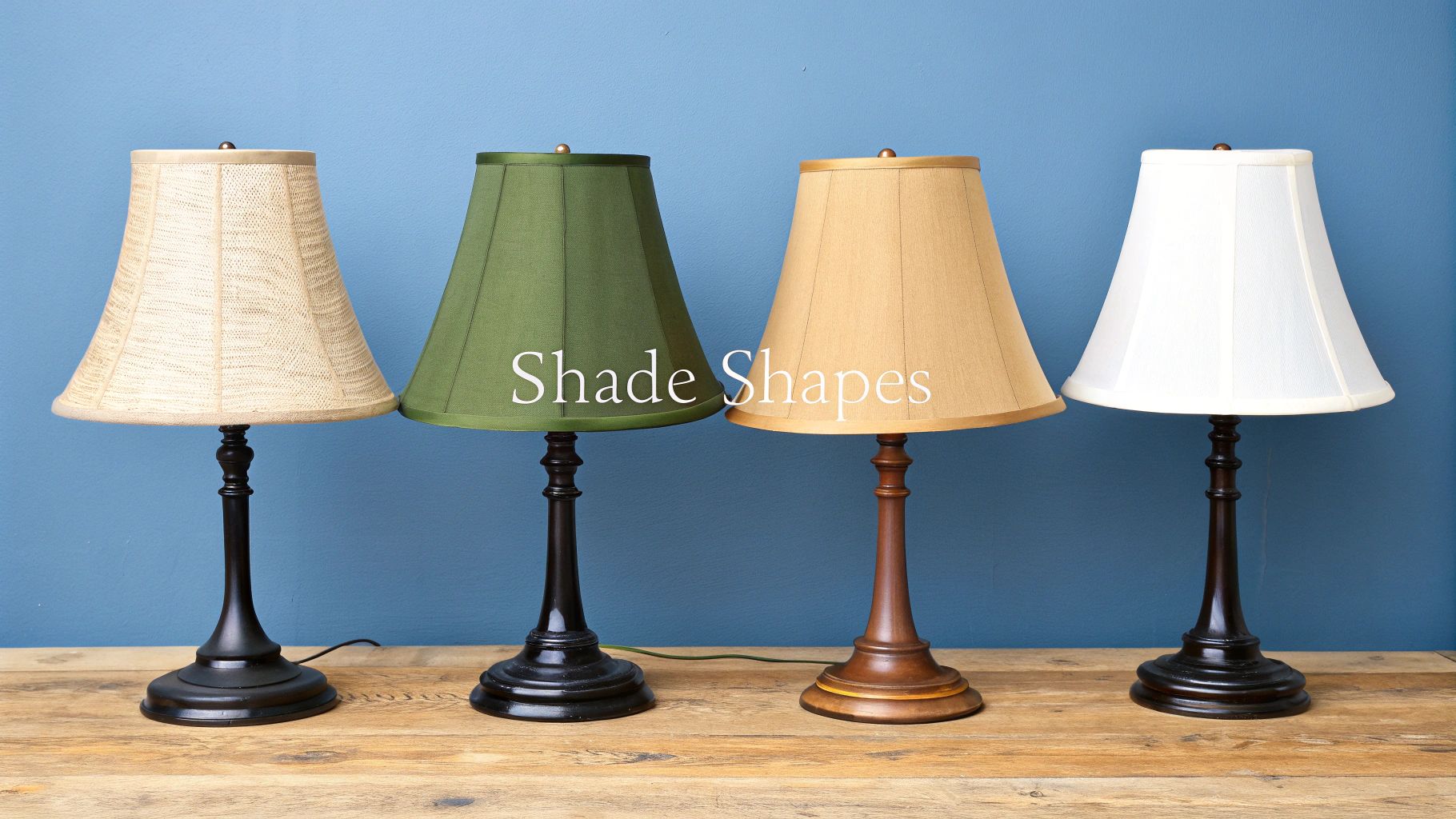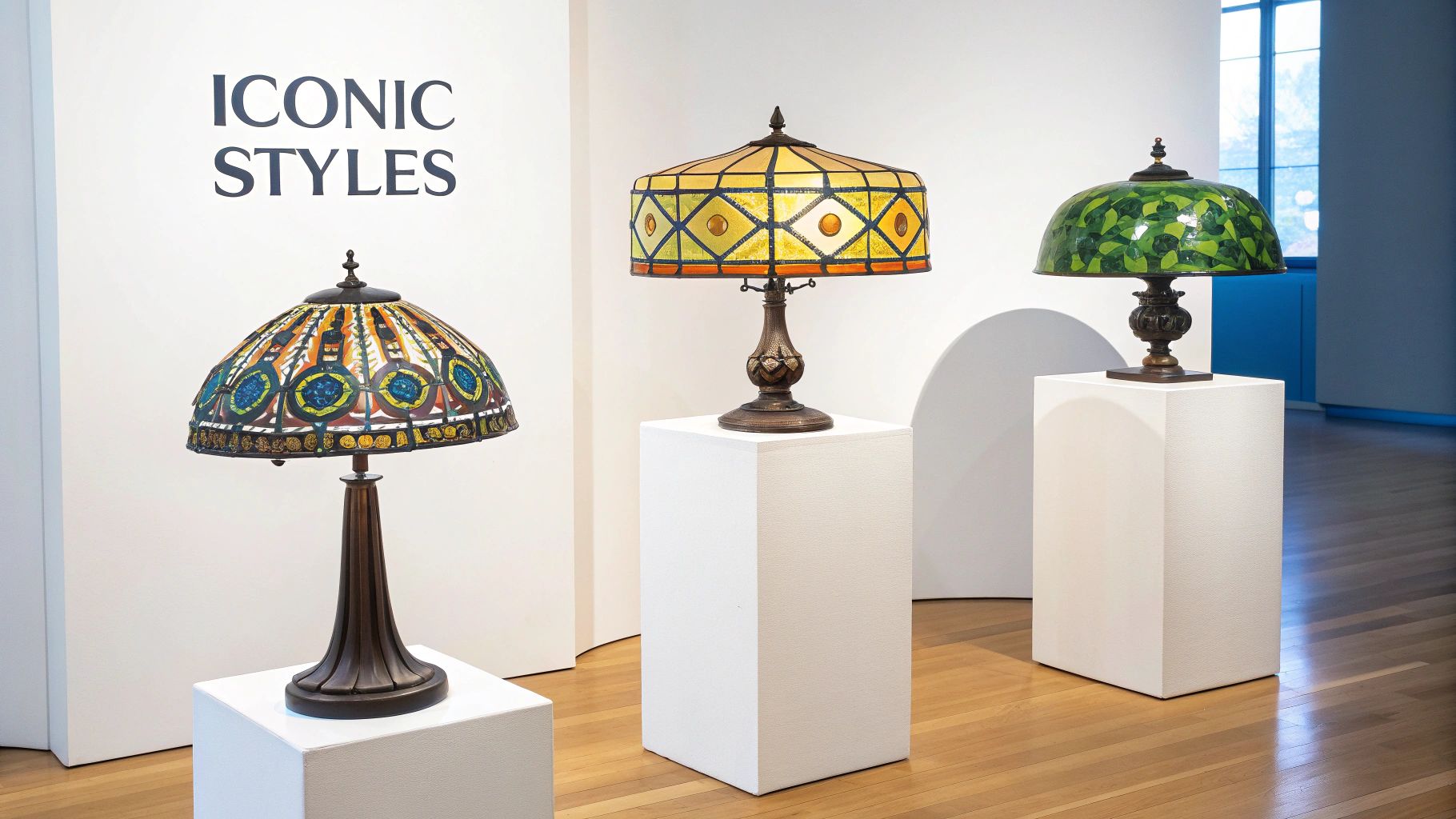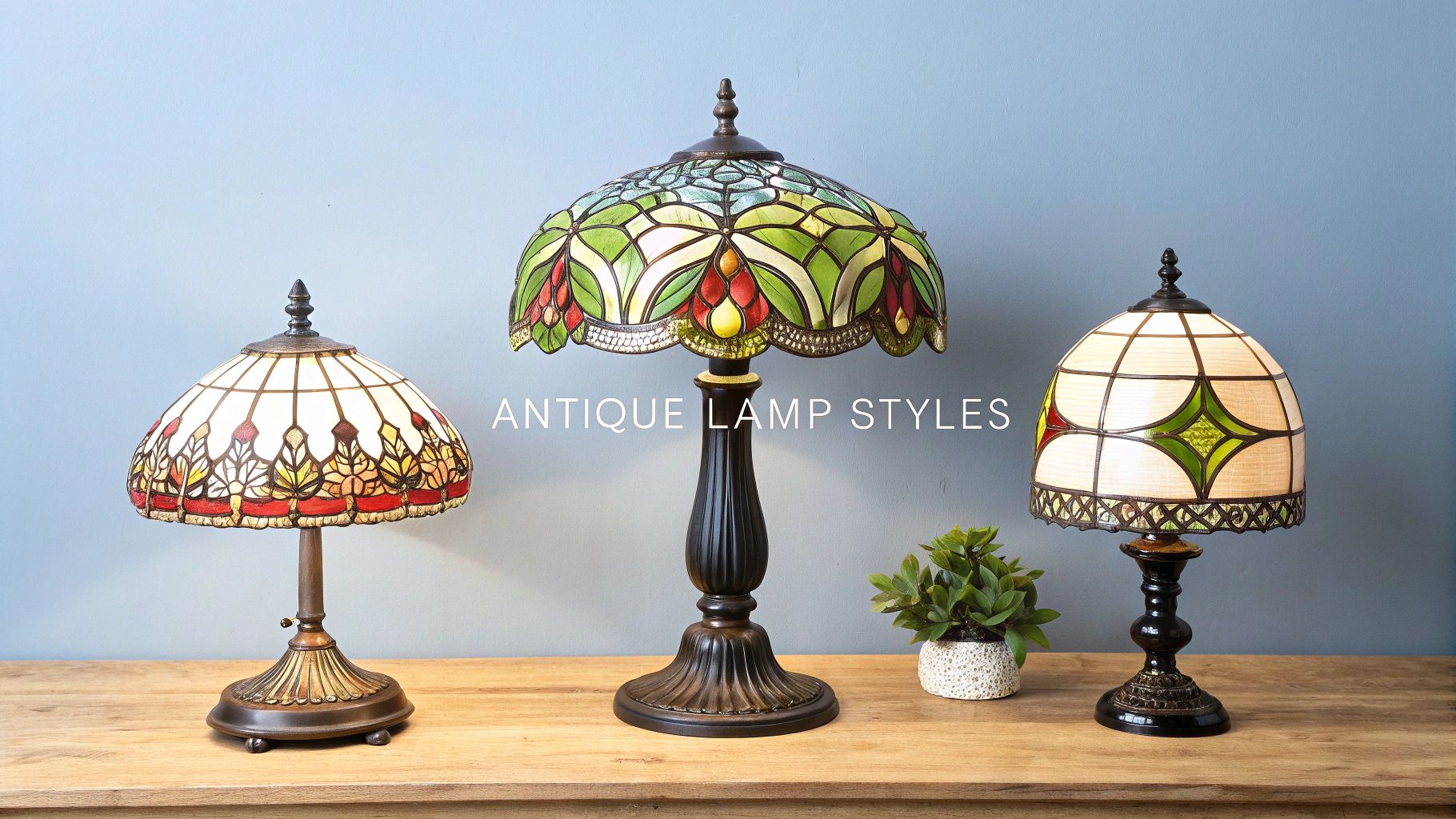Antique lamp shades are so much more than just a way to diffuse a lightbulb.They’re like little time capsules, offering a peek into the design trends of a bygone era—from the over-the-top fabrics of the Victorian parlors to the sharp, geometric cool of Art Deco. These aren't just functional objects; they're storytellers that can bring a massive dose of character and elegance to any room.
Why Antique Lamp Shades Remain Timeless Treasures

Unlike the endless stream of cookie-cutter shades you find in stores today, an antique lamp shade has a soul. Each one is a direct reflection of the art, materials, and hands-on craftsmanship of its day. Think of it as adding a piece of functional art to your home—something that doesn't just light up a corner but also starts a conversation.
When you choose an antique shade, you're buying into a legacy of quality and individuality. Many of these vintage pieces were painstakingly made by hand with luxurious materials like silk, fine linen, parchment, and of course, stained glass. They often feature hand-sewn details that you just don't see anymore. It's this commitment to quality that has allowed them to survive for decades, ready to tell their story in a new home.
What You Will Discover
This guide is your tour through the most iconic antique lamp shade styles. My goal is to help you confidently identify them, appreciate their little quirks, and maybe even spot a hidden gem on your next trip to a flea market or antique shop.
Here’s a quick look at the major styles we’ll be diving into:
- Victorian Shades: Think opulent, detailed, and dramatic. These shades are all about rich fabrics, intricate beadwork, and those classic decorative fringes that defined the Gilded Age.
- Tiffany (Art Nouveau) Shades: Instantly recognizable for their breathtaking stained-glass work, these shades often feature patterns pulled straight from nature—like delicate dragonflies, wisteria, and blooming flowers.
- Art Deco Shades: These shades capture the sleek glamour of the 1920s and 30s with their bold geometric shapes, clean lines, and luxurious materials.
By the end of this guide, you won't just see a lampshade; you'll see a piece of history. You'll understand how each curve, color, and material tells the story of a specific moment in time.
To give you a head start, here is a quick overview of the styles we'll be discussing.
Quick Guide to Antique Lamp Shade Styles
| Style | Era | Defining Features |
|---|---|---|
| Victorian | 1837–1901 | Ornate fabrics (silk, velvet), fringe, beadwork, elaborate shapes, dark colors. |
| Tiffany (Art Nouveau) | 1890–1910 | Stained glass, nature-inspired motifs (flowers, insects), intricate leaded designs. |
| Art Deco | 1920–1939 | Geometric patterns, stepped forms, bold colors, sleek materials like glass and metal. |
| Arts & Crafts | 1880–1920 | Simple, handcrafted look, natural materials (mica, wood), straight lines, earthy tones. |
| Mid-Century Modern | 1945–1969 | Abstract shapes, fiberglass, drum or cone forms, bright and playful colors. |
This table is just the beginning. Now, let’s get into the details of what makes each of these styles so unique and beloved. We'll start by exploring the foundational shapes and then see how you can bring these beautiful pieces into your own space.
How Lamp Shades Evolved From Function to Art
Long before they were ever considered decorative, lampshades were simply a practical solution to a common problem. Back in the 17th and 18th centuries, their job was to tame the wild, open flames of candles and oil lamps.
These early shades were all about function, not fashion. Often made from simple pierced tin or parchment, they shielded eyes from the harsh glare and, just as importantly, helped prevent fires. The idea was to control the light, making it usable and a bit safer. Beauty wasn't part of the equation yet.
The Incandescent Revolution
Then came the incandescent light bulb, and everything changed. As the Victorian era progressed, homes were suddenly filled with a brand-new kind of light—one that was steady, bright, and often uncomfortably harsh.
This leap in technology created an immediate need. The bare electric bulb was far too glaring for the cozy, ambient interiors people were used to. The old, purely functional shades just weren't up to the task of taming this powerful new light source, which sparked a creative explosion in lampshade design.
The lampshade's journey mirrors that of many great innovations. What begins as a purely practical solution to a problem often evolves into a canvas for artistic expression. The need to tame electric light didn't just create a new product; it created a new art form.
From Utility to Artistry
The story of the antique lampshade is really a story about art and technology. During the Victorian era (1837–1901), as electricity became more common, shades grew more and more ornate. Designers used lavish fabrics, delicate lace, and intricate beadwork to soften the stark glow of the bulb.
Then, during the Art Nouveau period (roughly 1890 to 1910), visionaries like Louis Comfort Tiffany took it a step further. He turned lampshades into breathtaking works of art with his iconic stained-glass designs, often featuring motifs from nature like dragonflies and wisteria. By the early 20th century, the lampshade had completed its transformation from a utilitarian shield to a true decorative centerpiece. You can see great examples of this evolution over at EleganceLamps.com.
Every major design trend left its fingerprint on the humble lampshade, turning it into a small reflection of the culture and style of its time. To really appreciate how these styles developed, it’s helpful to understand the major art history periods and their timeline, which had a direct hand in shaping these beautiful objects. It's this journey from simple fire guard to intricate art piece that makes antique lamp shades so fascinating.
Getting to Know the Four Classic Shade Shapes
Before you can really dive deep into the world of antique lamps, you need to know the basics. Think of it like learning the alphabet before you start writing. For lampshades, this means getting familiar with the four foundational shapes that pop up again and again, no matter the era.
These core shapes are the essential building blocks of vintage lighting. Once you can spot them, you'll start to see how designers throughout history have used them as a starting point for more elaborate and unique creations. It’s the key to speaking the language of antique lighting.

The Four Foundational Silhouettes
At their core, most antique shades are a variation of one of four primary shapes: drum, empire, bell, and coolie. Each one has a distinct profile that was popular for both its look and the way it cast light. Getting a handle on these is your first real step toward identifying antiques with confidence. If you want to go further, you can always explore more insights on vintage lighting styles.
- Drum Shade: Just picture a musical drum. This shade is a perfect cylinder, with a top and bottom that are the exact same size. Its clean, straight lines made it a huge hit during the Mid-Century Modern period, where minimalism was king.
- Empire Shade: This is what most people probably think of when they hear the word "lampshade." It's a classic cone shape—narrow at the top and gradually flaring out to a much wider bottom. It's so versatile that it was a staple in the early 20th century and looks good on just about any lamp base.
- Bell Shade: The name says it all. This shade flares out from a narrow top with a gentle, graceful curve, just like a bell. You'll often find them made of soft, flowing fabrics like silk, which gives them a romantic feel perfect for a bedroom.
- Coolie Shade: This one has the most dramatic slope of all. It starts with a tiny opening at the top and angles out to an extremely wide base, looking a lot like a traditional Asian conical hat. This design is fantastic at pushing light downward, making it a great choice for task lighting on a desk or next to a reading chair.
Learning to spot these four shapes is like learning the grammar of antique lighting. Each silhouette tells a story about its time—from the straightforward function of the coolie to the soft elegance of the bell.
Once you can comfortably identify these shapes, you've built a solid foundation. It's a skill that helps you quickly size up almost any lamp you come across, preparing you to tackle the more intricate and decorated antique lamp shade styles like Victorian or Tiffany.
Exploring Iconic Antique Lamp Shade Styles

Now that we've covered the four classic shapes, we can get to the fun part: seeing how different eras used them as a creative canvas. Artists and designers throughout history took these foundational forms and poured their own period's unique style into them. This is where the real personality of antique lamp shade styles shines through.
Let's take a little trip back in time to look at three of the most beloved and recognizable periods in lighting design. We'll start with the lavish Victorian era, move into the nature-infused Art Nouveau movement (home of the famous Tiffany lamp), and finish with the sleek glamour of Art Deco. Each style is a window into the culture, technology, and tastes of its day, showing how a simple light became a work of art.
Victorian Style: Opulence and Detail
The Victorian era (1837–1901) was all about abundance. If a little was good, more was better. Homes were packed with ornate furniture and heavy fabrics, and lampshades absolutely followed suit. The main idea was to create a cozy, luxurious glow, which was perfect for softening the harshness of the new gas and electric lights.
You won't find any minimalism here. Victorian shades were the showstoppers of the room, practically dripping with lavish materials and intricate details. Think of them as tiny, elaborate ball gowns for light bulbs.
Here's what to look for:
- Rich Fabrics: Deep jewel-toned silks, plush velvets, and detailed brocades were the go-to materials for creating that feeling of warmth and wealth.
- Intricate Details: Hand-sewn beadwork, elegant tassels, and long, flowing fringe weren't just add-ons; they were essential. They gave the shades texture, movement, and life.
- Complex Shapes: Frames were rarely simple. Designers preferred scalloped edges or multi-paneled constructions to create dramatic, eye-catching silhouettes.
Art Nouveau: The Natural World in Glass
As the 19th century drew to a close, a new style emerged that pushed back against rigid, formal designs. The Art Nouveau movement (1890–1910) looked to the natural world for inspiration, celebrating its flowing, organic forms. When it comes to lighting from this period, one name stands above all others: Louis Comfort Tiffany.
Tiffany developed a groundbreaking technique using individual pieces of colored stained glass. Each piece was carefully cut, wrapped in copper foil, and then soldered together. This process allowed for an incredible level of artistry, turning a simple shade into a luminous mosaic.
Tiffany-style shades aren't just for lighting a room; they're illuminated sculptures. They look beautiful even when the bulb is off, but the real magic happens when you flip the switch. The light streams through the glass, bringing the colors and stories to life and casting an enchanting glow.
You can spot a Tiffany-style shade by its:
- Stained-Glass Construction: They are meticulously built from hundreds, and sometimes thousands, of individual glass pieces.
- Nature-Inspired Motifs: Dragonflies, wisteria vines, peonies, and poppies are classic themes you'll see time and again.
- Leaded Designs: The dark solder lines aren't just functional; they create the distinct outlines that define the colored glass patterns.
Art Deco: Geometric Glamour
The Art Deco period (1920s–1930s) marked a huge shift in design, propelled by the rise of modern manufacturing and widespread electricity. Art Deco lighting fully embraced the new age with its streamlined, geometric forms and bold visual contrasts. Shiny chrome was often paired with frosted, sandblasted, or etched glass shades.
This era also gave us iconic pieces like the "Deco lady" lamp, which blended figurative sculpture with functional light to capture the period's obsession with modern elegance. You can learn more about how this era influenced vintage lighting on ledkia.com.
How to Choose and Style an Antique Shade
Bringing an antique lampshade into your home is more than just a purchase; it's about giving a piece of history a new life. But how do you make it look right? It's all about creating a beautiful, balanced relationship between the shade, its base, and the room it's in.
The first and most important rule is proportion. It's the secret to making a lamp look "right."
Get this wrong, and the whole thing can feel off. A huge shade on a skinny little base will look like a mushroom, while a tiny shade on a chunky base gets completely lost. A great rule of thumb is that the shade's height should be about two-thirds the height of the lamp base. The widest part of the shade should also be just a little wider than the widest part of the base.
Think of it like putting on a hat—you want one that complements your frame, not one that swallows you whole or perches awkwardly on top. This simple guideline creates a sense of visual harmony, letting both the shade and the base have their moment.
Matching Styles With Your Decor
Once you’ve nailed the proportions, it’s time for the fun part: style. You absolutely do not need a house full of antiques to enjoy a vintage shade. In fact, the magic often happens when you mix old with new. The trick is finding a common thread to tie it all together.
Here are a few ideas to get you started:
- Echo the Color: Got your eye on a vibrant Tiffany shade? Pull one of the less obvious colors from its glass and sprinkle it around the room in throw pillows or a piece of art. It’s a subtle move that makes the whole space feel thoughtfully designed.
- Repeat the Shape: Those clean, geometric lines of an Art Deco shade will look fantastic in a modern room that already has angular furniture or patterns. The shared language of shapes makes the pairing feel intentional.
- Play with Texture: A lavish Victorian shade with all its fringe and fabric can be a wonderful, soft counterpoint in a sleek, minimalist room. It adds a much-needed touch of warmth and personality.
As you explore, it can be helpful to look at how styles have evolved by comparing vintage finds with contemporary table lamp designs. You'll start to see what elements speak to you.
Common Mistakes to Avoid
Working with antique lamp shade styles is a joy, but a few common slip-ups can keep them from looking their best. One of the biggest mistakes is forgetting what the lamp is actually for. That dramatic, dark silk shade might look incredible, but it's not going to do you any favors in a reading nook.
"An antique lamp is both a historical artifact and a functional object. Its placement should honor both roles—casting beautiful light while adding a layer of history to the space."
Another trap is creating a style clash that just feels jarring instead of eclectic. Mixing eras is great, but make sure there’s a unifying element—color, material, or general mood—to keep things from feeling chaotic.
Finally, don't be shy! Show off your unique finds. If you're looking for new ways to highlight your favorite pieces, you can find some great collectible display ideas to get your creativity flowing. Sidestep these common pitfalls, and you'll be able to weave a piece of the past into your home with confidence.
Caring for Your Antique Lamp Shade

When you own an antique lamp shade, you’re not just an owner—you’re a custodian of a fragile piece of history. Proper care is all about preserving its beauty and integrity, and the golden rule is always to be gentle. After decades, materials like silk and parchment can become incredibly brittle.
For most fabric shades, your best friends are a soft, dry paintbrush or a clean microfiber cloth. Use them for regular dusting, but never introduce water or liquid cleaners, especially on silk or parchment. Moisture can cause irreversible stains and weaken the material's structure.
The careful approach needed here is a lot like handling other delicate antiques. If you're interested in learning more about these gentle preservation techniques, our guide on how to clean antique bottles shares similar principles.
Cleaning Specific Materials
Different materials mean different cleaning rules. A sturdy stained glass shade needs a different touch than a whisper-thin silk one.
- Stained Glass: These are the tough guys of the antique lamp world. Dust with a dry cloth. If you find some built-up grime, you can use a cloth slightly dampened with water and a tiny drop of mild soap. Just be sure to wipe it completely dry right after and stay far away from abrasive cleaners.
- Fabric and Silk: Gentle, regular dusting is everything. If you notice a spot or stain, your best bet is to consult a professional textile conservator. Trying to clean it yourself can easily lead to a tear or permanent discoloration.
- Parchment: Dust only. These shades are extremely sensitive to moisture, so keep them out of humid spaces like bathrooms or basements to prevent warping or mildew.
The goal is always preservation, not aggressive cleaning. Avoid harsh chemical sprays, rough cloths, and never, ever submerge any part of an antique shade in water.
Electrical Safety and Professional Help
Keeping the shade clean is one thing, but making sure the lamp is safe is another. The wiring on vintage lamps is often dangerously outdated and can be a serious fire hazard.
If you ever see frayed cords, a flickering light, or a wobbly socket, unplug the lamp immediately.
Before you even think about using an antique lamp regularly, have a qualified electrician inspect it. They can update the wiring, making sure your beautiful piece is safe to enjoy in your home. This simple step allows its historic charm to shine brightly—and securely—for years to come.
A Few Common Questions About Antique Lamp Shades
Diving into the world of antique lighting can feel a bit like a treasure hunt, and it's natural to have questions along the way. Whether you've been collecting for years or just snagged your first beautiful find, getting clear answers is always helpful. Let's tackle some of the most common things people wonder about when it comes to antique lamp shades.
We’ll get into the practical stuff, like how to tell a real antique from a convincing fake and the best places to look for them. We'll also cover safety, because enjoying a piece of history in your home should come with complete peace of mind.
How Can I Tell if a Shade Is a True Antique?
Spotting a genuine antique is all about looking closely at the materials, the way it was made, and the subtle signs of a long life. It’s a bit of detective work.
True antiques almost always have small imperfections that tell their story—think hand-stitched seams on an old fabric shade or tiny bubbles and waves in the glass of a Tiffany-style piece. They also show wear that makes sense for their age, not something that looks artificially distressed. Reproductions, on the other hand, often look a little too perfect and might be made with modern materials that just don't feel right. Always check for a maker's mark, but don't panic if you don't find one, as not all old pieces were signed.
When in doubt, the story is in the details. Hand-soldered lead lines, original fabric that has gracefully aged, and period-specific construction techniques are the fingerprints of a true antique.
Where Can I Find Authentic Antique Shades?
If you know where to search, authentic antique lamp shades are out there waiting to be found.
- Specialized Antique Stores: These shops are a great starting point. The owners are often passionate experts and have already curated a collection of quality pieces.
- Estate Sales: This is one of my favorite ways to find items. You often get to learn the history of the piece directly from the family.
- Reputable Online Marketplaces: Sites dedicated to antiques can be goldmines. Just be sure to find sellers who provide tons of photos, detailed descriptions, and have excellent reviews from other buyers.
You can also stumble upon treasures at flea markets and auctions, but you'll need a sharp eye to sift through the reproductions and find the real gems.
Is It Safe to Use Old Lamps With Modern Bulbs?
Yes, it is—and in fact, you absolutely should! But there are a couple of crucial steps you need to take first. Before you even think about plugging it in, have the lamp's wiring checked by a professional. If the cord is brittle, frayed, or original to the lamp, it must be professionally rewired. This is non-negotiable and prevents a serious fire hazard.
Once the wiring is safe, always use an LED bulb. LEDs are a game-changer for antique lamps because they produce almost no heat. This is critical for protecting fragile old materials like silk, paper, or delicate glass from becoming brittle and cracking over time. Just make sure the bulb fits the socket and stay well below the lamp's original wattage recommendation to be safe.
Have a potential antique lamp shade and want to know its story and value? Let Curio be your guide. Just snap a photo, and our app provides instant identification, historical context, and an estimated appraisal, turning your curiosity into expertise. Download Curio today at https://www.curio.app.
